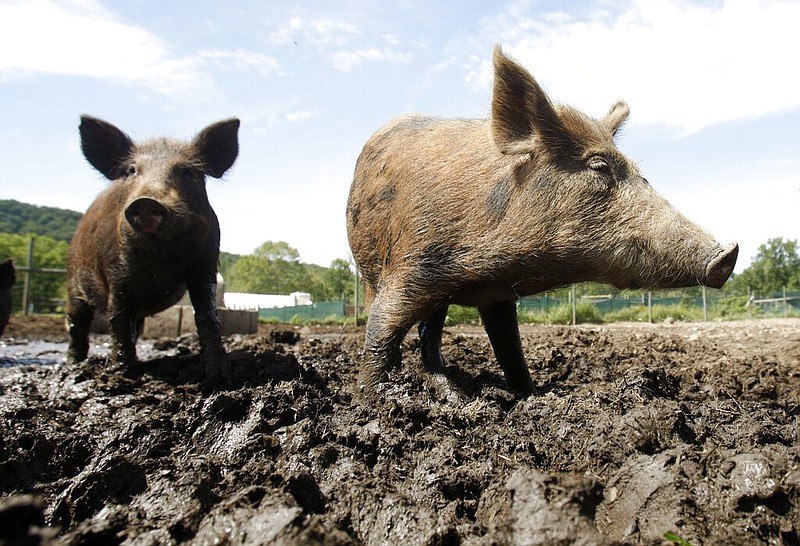Eliminating the state's destructive feral hog population isn't all about attacking them with guns blazing.
The task requires efficiency, patience and money.
The latest U.S. Department of Agriculture survey data estimates feral swine cause at least $41 million in damage to crops every year in Arkansas, to include $34 million in damage to corn, soybeans, rice, cotton, wheat, hay and pecans, as well as $7.3 million in damage to livestock, according to a recent state Department of Agriculture news release.
Feral swine are an invasive species that are destructive to crops and will eat young domestic livestock, birds that nest on the ground, eggs and fawns. The hogs carry up to 45 bacteria, parasites and diseases to include the swine herpes virus, brucellosis and trichinellosis, according to the Arkansas Game and Fish Commission's website.
The state's Feral Hog Eradication Task Force culled approximately 30,000 feral hogs from January to the end of May. The task force was created by the state Legislature in 2019 and is comprised of 21 federal and state agencies and non-governmental organizations.
The state Department of Agriculture announced recently that additional grant funding is available for feral hog eradication efforts.
The grants include $650,000 in federal funding through the Consolidated Appropriations Act of 2022 for the department to expand eradication efforts across the state. The Buffalo River Conservation Committee allocated grants totaling $74,960 in 2021 and 2022 to the USDA's Animal and Plant Health Inspection Service Wildlife Services program to expand eradication efforts within the Buffalo River watershed.
The eradication of feral hogs generally happens after damage to property has occurred. Personnel will assess where the damage occurred and use methods like trapping and ground shooting to remove the hogs.
But rather than actively hunt or search for feral hogs, most agencies typically remotely monitor them via game cameras associated with bait stations to observe patterns of activity, determine the size of a family of hogs, or sounder, and their locations.
Wildlife Services offers feral swine management services statewide upon request and there are 20 full-time trappers in Arkansas, according to the Arkansas Department of Agriculture Natural Resources Division.
Multiple agencies help out with the eradication efforts, including the USDA's Animal and Plant Health Inspection Service, Arkansas Game and Fish Commission, the University of Arkansas Cooperative Extension Service and local conservation district personnel, all funded through grants.
Using some of the new grant money, Wildlife Services purchased three new trapping systems and materials to build 12 additional traps, as well as trap panels, corn and other items for feral hog management. Wildlife Services has worked with 43 private landowners within the Buffalo River Watershed and culled 558 feral hogs.
The state Department of Agriculture's Natural Resources Division is working with Wildlife Services on a plan for the new grant funding to mirror or complement the USDA's Feral Swine Control Project, established by the 2018 Farm Bill to respond to the threat feral swine pose to agriculture. Ideas include hiring extra labor positions like technicians within the Department of Agriculture. The technicians would conduct coordinated feral swine removal efforts in certain areas.
There are ongoing discussions about which areas in the state would be most suitable for elimination efforts.
Education, outreach, data collection and targeted marketing to get landowner assistance in project areas are also being considered as part of expanded eradication efforts.
"The projects are in the development and planning stages," said a news release from the state Natural Resources Division. "We are hopeful that we can allocate and appropriate the funds beginning in September 2022 and conclude the project twelve to eighteen months after initiation."
